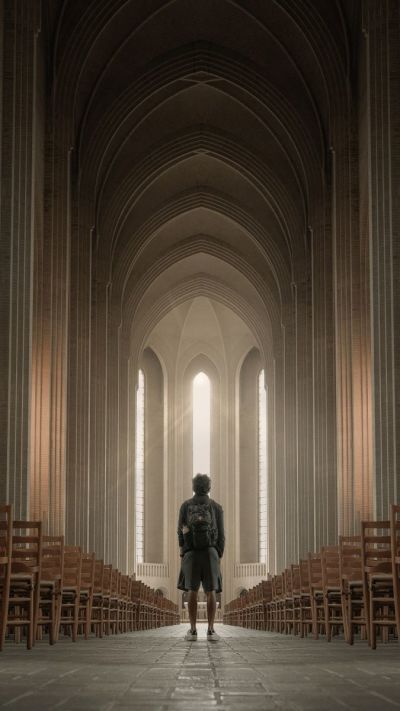Revelation 11: The temple and its place in the divine economy

We currently live in an era when temples, church buildings and other religious edifices are mostly diminished in importance. We rightly understand God to be everywhere, and it isn’t necessary to go to a building to find Him.
Of course, the New Testament speaks of the Church as the Temple of God (Ephesians 2:20). However, one cannot read the Bible without noticing that the Temple, the building, is given a place of prominence in God’s economy.
There have been two Temples in the history of Israel. First, Solomon’s Temple was a matchless structure of beauty but was ultimately destroyed by King Nebuchadnezzar of Babylon in approximately 590 B.C. Seventy years later, when the Babylonian captivity ended, Cyrus, the King of Persia, allowed some Jews to return to Jerusalem, and they built the Second Temple under the leadership of Zerubbabel around 520-515 B.C. Zerubbabel’s Temple was desecrated by Antiochus Epiphanes, a Greco-Syrian Ruler who erected a statue of the god Zeus and sacrificed a pig on the altar. King Herod would later remodel and expand the Second Temple under Roman occupation. However, in 70 A.D., the Romans utterly destroyed it to put down rebellious Jewish factions.
In Revelation chapter 11, John is transported into the future to see another Temple. It must be another or a Third Temple, because the first Temple was long gone, and the Second Temple, the one of John’s day, had been destroyed 20 years before John gave his account. This is the only way to understand the passage unless one spiritualizes the Temple as a symbol of the Church, which leads to considerable confusion.
Here’s what John said:
“Then I was given a measuring stick, and I was told, ‘Go and measure the Temple of God and the altar and count the number of worshipers. But do not measure the outer courtyard, for it has been turned over to the nations. They will trample the holy city for 42 months'” (Revelation 11: 1-2).
The text begs an important question: If temples or edifices dedicated to the worship of God are of little consequence, why would they have such a prominent place in past and future dispensations?
An executive order issued by North Carolina’s Governor Roy Cooper in 2020, during the height of the COVID pandemic, caused me to consider this question’s importance.
Governor Cooper’s executive order essentially closed church buildings. Outdoor church services were allowed if strict social distancing was exercised. Drive-in services were acceptable if people remained in their cars. Indoor worship services and weddings were only approved for gatherings of ten people or fewer in the same confined space.
Fortunately, the constitutionality of the Governor’s executive order was challenged in court and knocked down. Nevertheless, the circumstances brought to the fore particular religious beliefs prescribing why corporate worship services are preferable inside an edifice consecrated to the veneration of God and his ways.
There are specific reasons for church buildings and their beautiful sanctuaries, which go far beyond protecting parishioners from the elements. Unfortunately, sometimes these reasons are little understood, and the Church’s members unwittingly disparage their importance.
The point of the church sanctuary is to provide a place where the atmosphere is conducive to inspiring one to worship, which is not always an easy task for earth-bound, fleshly entities such as ourselves. The sanctuary doesn’t resemble a place in the commercial or the secular world; neither is it even like our home life. Instead, it’s more of a refuge from the troubles and anxieties of what is mostly a profane and irreligious world.
Christians of yesteryear seemed to understand this better than some believers today. So, they constructed grand cathedrals and church houses to reflect God’s majesty and provoke the most profound experience of worship from the people.
Undoubtedly, this is one of the tremendous lessons that may be garnered from God’s pleasure in the temple.
Although I am not a Catholic, Msgr. Charles Pope, a Catholic writer, presents the argument marvelously, saying:
“Churches are meant to remind us of Heaven. Until recent decades, they were built along lines that spoke to heavenly realities both Moses and John saw as they were shown the heavenly worship and vision. Churches have high jeweled (stained glass) walls because Heaven does. Churches have glorious throne-like altars with the tabernacle at the center amidst tall candles because in Heaven, there is a throne-like altar with the Lamb upon it, and Jesus stands among the lampstands. Painting and statues of saints and angels, incense, priestly robes, standing/kneeling appropriately, and singing hymns remind us of the communion of saints and angels in the heavenly worship. All of this is revealed in the heavenly visions contained in the Bible.”
In other words, whether Catholic or Protestant, the externals for corporate worship have a spiritual purpose in assisting us to focus entirely on God, His Kingdom, and his will for our lives.
Brian Kingslake, in Out of This World, also addresses the question of the importance of the temple, so to speak. He says:
“The whole subject of the relationship between the externals and the internals of religion is very interesting. Just as the stone walls and locked doors of a church building protect the altar Bible, the Communion vessels, and the rich carpets of the sanctuary so the externals of religion can protect and preserve the more precious worship of the heart. The fact that we discipline ourselves to attend service in a certain building at a definite hour and take part in a certain ritual that has evolved during the ages, can help to preserve and protect our spiritual consciousness. To depend entirely on one’s spiritual vitality is beyond the capacity of most of us. Structure can get in the way, but without any structure, there is a tendency for our thoughts to dissipate and degenerate into trivial and superficial or sentimental nothingness. We need to get together with our friends from time to time to ‘fill our tanks at the filling station to recharge our flat batteries.”
Many pastors tell me large swaths of their congregations have not returned to their churches since the pandemic, but they are watching streamlined services over the internet. Quite frankly, this misses much of the point of going to Church.
There is still something else to see here about corporate worship.
John indicates there will be a future Temple in Jerusalem during the end times. Because of where this passage falls in the Book of Revelation, it is apparently a part of the Tribulation period.
The Jews have always wanted to build another Temple. It’s the very heart and soul of their religion. But the current Temple Mount in Jerusalem is occupied by the Dome of the Rock — an Islamic Shrine where Muslims believe Mohammed ascended into Heaven. Trying to move it would create a world conflict. However, John sees a Third Jewish Temple; how this comes about is unclear and left to much speculation.
The command for John to measure the temple and its worshipers, says George Eldon Ladd, has nothing to do with determining their actual dimensions. It’s a metaphor. It’s a symbol of setting aside something for preservation or destruction. Ladd writes:
“Zechariah saw a man measuring Jerusalem, which was symbolic of her divine protection (Zechariah 2:1-5). Ezekiel had an elaborate vision of measuring Jerusalem — a symbol of the fact that Jerusalem would yet become the true city of God (Ezekiel 40-43). In other places, measuring is a symbolic act indicating destruction rather than preservation (II Kings 21:13; Isaiah 34:11; Lamentations 2:8). In John’s vision, the measuring of the temple, its inner courts, and those who worship there is a symbol of preservation and protection … The key to our understanding of this passage is found in the fact that the outer court and the entire city of Jerusalem are both trampled by the Gentiles. The most natural meaning of Jerusalem is that it stands for the Jewish people. When Jesus spoke of the trampling of Jerusalem by the Gentiles (Luke 21:24), he meant to designate the city as representative of the entire people. When in contrast to the city as a whole, the temple proper and its worshipers are preserved, the contrast seems to be between the Jewish people as a whole and a remnant who are true worshipers of God. Historically, all Jews had access to the inner court of Israel to engage in the worship of God. Yet it is obvious that here the Temple and its worship cannot represent all Israel, for they stand in contrast to the outer court and to the city of Jerusalem as a whole, which represents the nation. This suggests a contrast between a faithful remnant of believing Israelites who, in contrast to the city as a whole (the holy city), are true worshipers of God. Israel as a whole will be trodden down by the nations — they will fall under the divine judgment because they have become spiritually apostate.”
So, what can we learn from this about worship?
The spiritual apostasy of the Jews is that they would look to the sacrifices of bulls and goats in the Temple for their salvation rather than the one sufficient sacrifice of Christ on the Cross. In the end, only the true worshipers of God will be preserved and saved. Those who seek to worship in some other way, God will reject. In this dispensation and the Tribulation period, all must come to him solely based on the shed blood of Jesus.
Today church buildings and temples are full of people counting on their membership, baptism, confirmation, attendance record and services in the name of God for their salvation. Others attempt to get into God’s favor through another religion and not Christianity. But unless we realize our spiritual bankruptcy as sinners and cast our only hope of redemption in Jesus Christ as Savior, we cannot be considered authentic worshipers of the Lord.
Jesus said we are to worship God “in spirit and truth” (John 4:23), meaning worship must genuinely flow from the heart and conform to God’s disclosure of himself in Scripture.
Rev. Mark H. Creech is Executive Director of the Christian Action League of North Carolina, Inc. He was a pastor for twenty years before taking this position, having served five different Southern Baptist churches in North Carolina and one Independent Baptist in upstate New York.




























